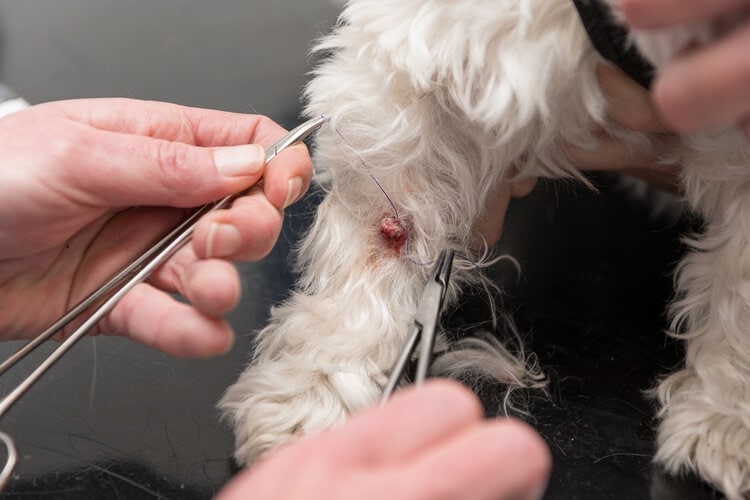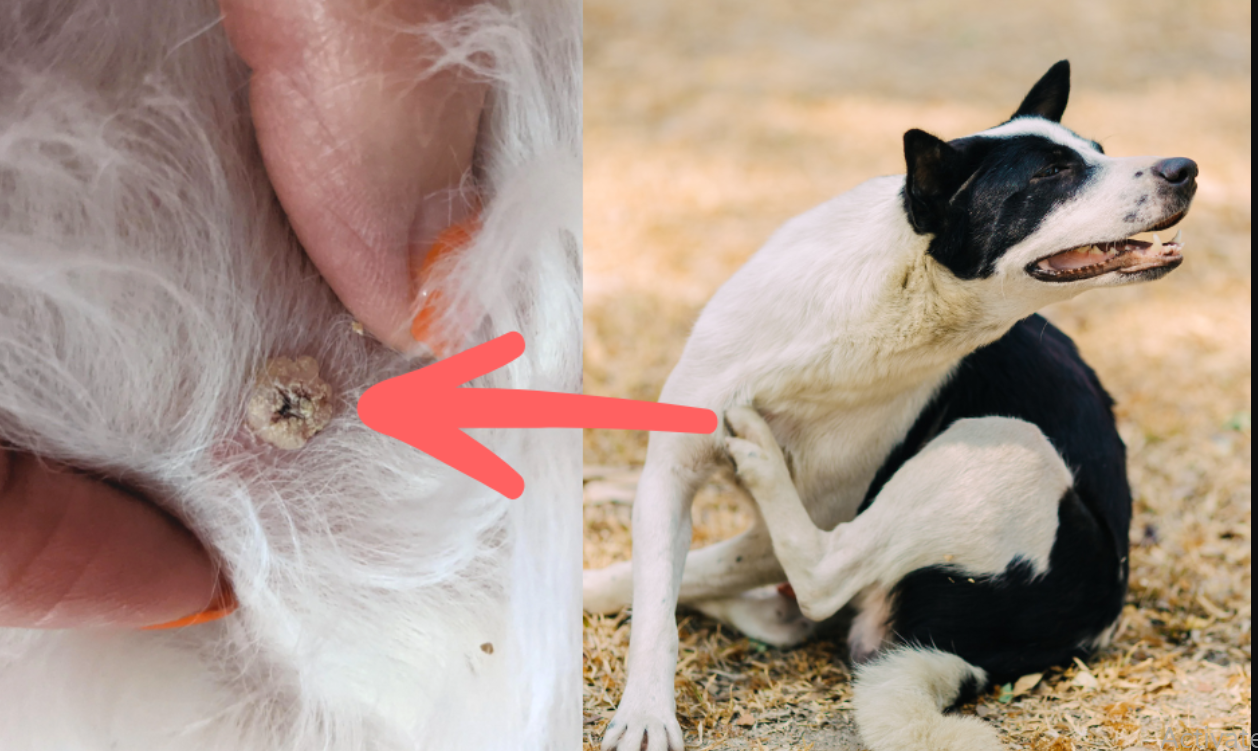Understanding Older dog Getting Skin Tags
Older dogs often develop skin tags, which are generally harmless growths. Older dog getting skin tags is a common occurrence and typically not a cause for concern. These skin tags can appear anywhere on a dog’s body and vary in size and color. They are usually soft, flesh-colored, and painless, and can be flat or hang off the skin by a thin stalk. While they typically do not cause any discomfort, it’s essential for pet owners to keep an eye on these growths to ensure they do not change in size, color, or shape.
Skin tags are benign, meaning they are non-cancerous and often not a cause for concern. However, monitoring them is crucial as any sudden changes could indicate an underlying issue. Older dog getting skin tags might be due to various factors, including genetics, friction from collars or harnesses, and natural aging processes.
Understanding what skin tags look like and how they behave is vital for any dog owner. Here are some key points to note:
- Appearance: Skin tags in older dogs are usually small, soft, and the same color as the surrounding skin.
- Location: They can develop anywhere on the body but are commonly found in areas where the skin folds or where there is friction.
- Texture: They are typically smooth and can be either flat or slightly raised.
- Growth: Most skin tags grow slowly and do not spread to other parts of the body.
It’s also important to distinguish skin tags from other types of skin growths, such as warts, cysts, or tumors. If you’re unsure whether a growth on your dog is a skin tag, consult your veterinarian for a proper diagnosis. Regularly checking your dog’s skin during grooming sessions can help you detect any new skin tags early and monitor existing ones for any changes.
Keeping track of these growths and understanding the nature of skin tags can help ensure that your older dog remains healthy and comfortable.
Further Reading:
5 OF THE MOST COMMON SKIN PROBLEMS IN DOGS
from https://www.primadog.com/dogs-health/5-most-common-skin-problems-dogs
Causes of Skin Tags in Senior Dogs
Older dog getting skin tags is a common phenomenon, and there are several underlying causes for this condition. Understanding these causes can help pet owners take better care of their senior dogs and manage the occurrence of skin tags effectively. Here are the main reasons why older dogs develop skin tags:
- Age: As dogs age, their skin undergoes changes, losing elasticity and collagen. This natural aging process makes older dogs more susceptible to developing skin tags. The skin becomes thinner and more prone to growths as it loses its ability to repair itself quickly.
- Genetics: Some breeds are genetically predisposed to developing skin tags. For instance, certain breeds have skin folds or loose skin, which can increase the likelihood of skin tags forming. If your dog’s breed is known for having such characteristics, it’s essential to monitor their skin closely.
- Friction: Areas where the skin folds or rubs against itself or other surfaces are prone to developing skin tags. Common spots include the neck (due to collars), armpits, and groin area. The constant friction in these areas can cause irritation, leading to the formation of skin tags.
- Hormonal Changes: Fluctuations in hormones can lead to the growth of skin tags in older dogs. Hormonal imbalances, especially those related to thyroid or adrenal gland function, can affect the skin’s health and contribute to the development of skin tags.

Knowing these causes helps pet owners understand why their older dogs might be getting skin tags and what they can do to minimize them. For instance, reducing friction by adjusting collars or using harnesses instead, maintaining regular veterinary check-ups to monitor hormonal health, and keeping an eye on any genetic predispositions can all be helpful strategies.
Identifying Skin Tags on Elderly Dogs
Identifying skin tags on your senior dog is crucial for proper monitoring and ensuring their overall health. Older dog getting skin tags is a common issue, and recognizing these growths early can help you manage them effectively. Here are some key features to look for when identifying skin tags on your elderly dog:
- Small, Soft, Fleshy Growths: Skin tags in older dogs often appear as small, soft, and fleshy growths. They can be easily moved and are typically not attached firmly to the underlying skin. These growths can vary in size, from a few millimeters to a centimeter or more in diameter.
- Similar in Color to Your Dog’s Skin: Skin tags are usually the same color as your dog’s skin. They may be slightly darker or lighter, but they generally blend in with the surrounding skin, making them less noticeable unless closely inspected.
- Painless and Non-Bleeding: Most skin tags are painless and do not cause any discomfort to your dog. They should not bleed unless they are irritated or injured. If you notice that a skin tag is causing pain or bleeding, it’s important to consult your veterinarian, as this could indicate a more serious issue.
In addition to these characteristics, skin tags are typically benign and non-cancerous. However, it’s essential to differentiate them from other types of skin growths, such as warts, cysts, or tumors, which may require different treatments.
To accurately identify skin tags, perform regular checks during grooming sessions. Run your hands gently over your dog’s body to feel for any new or unusual growths. Pay special attention to areas where friction is common, such as the neck, armpits, and groin.
When to Worry About Dog Skin Tags
While most skin tags on older dogs are benign and harmless, there are certain instances when they should be checked by a veterinarian. Older dog getting skin tags is a common occurrence, but it’s important to know when these growths might indicate a more serious problem. Here are some signs to watch for:
- Rapid Growth: A skin tag that grows quickly should be examined by a vet. Normal skin tags tend to grow slowly, so any rapid increase in size could be a sign of an underlying issue that needs professional evaluation.
- Color Change: Changes in color can indicate underlying issues. If a skin tag changes from its usual color to a darker or lighter shade, or if it becomes red or inflamed, it’s important to have it checked by a vet. Color changes can sometimes signal infections or other skin conditions.
- Bleeding or Ulceration: Any skin tag that bleeds or becomes ulcerated needs veterinary attention. Bleeding can be caused by the tag being irritated or injured, but persistent bleeding or ulceration might indicate a more serious problem, such as an infection or a malignant growth.
- Discomfort: If the dog is licking or scratching the tag excessively, it might be causing discomfort. This can lead to irritation, bleeding, and even infection. Excessive attention to a skin tag by your dog is a sign that it may be bothering them, and a vet should be consulted to determine the best course of action.
Home Remedies for Dog Skin Tags
Before trying any home remedies for older dog getting skin tags, it is essential to consult with your vet to ensure the safety and health of your pet. Once you have the go-ahead from your vet, you can consider these safe and natural options to manage skin tags at home:
- Apple Cider Vinegar: Apple cider vinegar is a popular home remedy for various skin conditions due to its acidic properties. To use it on a skin tag, soak a cotton ball in apple cider vinegar and apply it directly to the tag. Hold the cotton ball in place for a few minutes, or secure it with a bandage for a more prolonged application. Repeat this process two to three times a day. The vinegar’s acidity can help dry out the skin tag, causing it to eventually fall off. Be sure to monitor the area for any signs of irritation and discontinue use if your dog shows any discomfort.
- Castor Oil: Castor oil is known for its moisturizing and healing properties. To use castor oil on a skin tag, apply a small amount directly to the tag and gently massage it in. You can do this once or twice a day. Over time, castor oil may help shrink the skin tag. It is a gentle option, making it suitable for dogs with sensitive skin. Consistency is key with this remedy, as it may take several weeks to see results.
- Vitamin E Oil: Vitamin E oil is renowned for its skin-healing properties and can be beneficial for treating skin tags. Apply a small amount of vitamin E oil directly to the skin tag and massage it in gently. You can do this once or twice a day. Vitamin E oil helps in moisturizing the skin and promoting healing, which can lead to the gradual reduction of the skin tag. This remedy is safe and effective, especially for older dogs with dry or aging skin.
Vet Treatments for Dog Skin Tags
When home remedies aren’t effective or if the skin tags are causing problems for your older dog, there are several veterinary treatments available to ensure your pet’s comfort and health. Older dog getting skin tags might sometimes require professional intervention, especially if the tags are causing discomfort or showing signs of complications. Here are some common veterinary treatments for dog skin tags:
- Cryotherapy: Cryotherapy involves freezing the skin tag off using liquid nitrogen. This method is quick and relatively painless. The extreme cold destroys the tissue of the skin tag, causing it to fall off after a few days. Cryotherapy is a good option for small to medium-sized skin tags and is performed in a vet’s office. It’s a minimally invasive procedure that usually doesn’t require anesthesia.
- Surgical Removal: Surgical removal is a straightforward procedure where the vet surgically excises the skin tag. This can be done under local or general anesthesia, depending on the size and location of the tag, as well as the temperament of the dog. Surgical removal is often recommended for larger or problematic skin tags that might be prone to irritation or infection. The procedure is quick, and recovery time is usually short, with minimal post-operative care required.
- Laser Removal: Laser removal is a non-invasive option that uses laser technology to remove the skin tag. This method is precise and reduces the risk of infection and bleeding. The laser effectively cuts and seals the tissue, making it a clean and efficient option for removing skin tags. Laser removal is usually done under local anesthesia and is ideal for dogs that have multiple skin tags or tags in sensitive areas.
Further Reading:
Effective Solutions for Joint Pain in Older Dogs: Treatments and Tips 2024
from https://myolderdog.com/effective-solutions-joint-pain-in-older-dogs/
Natural Treatments for Dog Skin Tags
For those who prefer natural treatments, there are several options available to help manage skin tags in older dogs. Older dog getting skin tags is a common issue, and while veterinary treatments are effective, natural remedies can also provide relief and promote skin health. Here are some natural treatments to consider:
- Herbal Remedies: Herbal extracts like neem oil can be beneficial for treating skin tags. Neem oil has antifungal, antibacterial, and anti-inflammatory properties that can help reduce skin tags. To use neem oil, apply a small amount directly to the skin tag using a cotton swab. Be sure to monitor your dog for any signs of irritation and discontinue use if any adverse reactions occur.
- Dietary Supplements: Omega-3 fatty acids, found in fish oil and flaxseed oil, are known to improve skin health and overall wellness in dogs. Adding omega-3 supplements to your dog’s diet can help maintain healthy skin and reduce the occurrence of skin tags. Consult your vet for the appropriate dosage based on your dog’s size and health needs. Regular supplementation can promote smoother, healthier skin and reduce inflammation.
- Essential Oils: Essential oils, such as tea tree oil, can be effective in treating skin tags, but they should be used with caution. Tea tree oil has antimicrobial and anti-inflammatory properties that can help reduce skin tags. However, it is crucial to dilute tea tree oil before applying it to your dog’s skin. Mix a few drops of tea tree oil with a carrier oil, such as coconut oil, and apply it directly to the skin tag. Use this treatment sparingly and monitor your dog for any signs of irritation or allergic reaction. Essential oils should never be ingested by dogs and should always be used under the guidance of a veterinarian.
Best Practices for Removing Dog Skin Tags

If you decide to remove a skin tag from your older dog at home, it’s essential to follow proper guidelines to ensure the procedure is safe and effective. Older dog getting skin tags is common, and while veterinary intervention is often recommended, some pet owners may opt for home removal. Here are the best practices to follow:
- Sterilize Equipment: Ensuring all tools are clean and sterile is crucial to prevent infection. Use rubbing alcohol or a sterilizing solution to clean scissors, clippers, or any other tools you plan to use. Have sterilized gauze and antiseptic wipes on hand to clean the area before and after the procedure.
- Restrain Your Dog: Make sure your dog is calm and restrained to avoid sudden movements that could cause injury. Have a friend or family member help you hold your dog gently but firmly. You can use a muzzle if your dog tends to nip when anxious. Speaking to your dog in a soothing voice and providing treats can help keep them calm.
- Monitor for Infection: After removing the skin tag, keep an eye on the area for signs of infection. Signs to watch for include redness, swelling, discharge, or if your dog seems to be in pain. Apply an antiseptic to the area immediately after removal and continue to apply it for a few days. If you notice any signs of infection, contact your veterinarian immediately.
Preventing Skin Tags in Aging Dogs
While some factors contributing to skin tags in older dogs are beyond control, there are several steps you can take to minimize the risk and maintain your dog’s skin health. Older dog getting skin tags is a common issue, but with proper care and preventive measures, you can reduce the likelihood of their occurrence. Here are some best practices to help prevent skin tags in aging dogs:
- Regular Grooming: Keeping your dog clean and well-groomed is essential for maintaining healthy skin and reducing the risk of skin tags. Regular grooming helps remove dirt, debris, and dead skin cells that can contribute to skin irritation and the formation of skin tags. Brush your dog’s coat regularly to prevent matting and check for any signs of skin issues during grooming sessions. Bathing your dog with a gentle, dog-friendly shampoo can also help keep their skin healthy and clean.
- Healthy Diet: A balanced diet is crucial for overall skin health and can help prevent skin tags. Ensure your dog is getting the necessary nutrients, vitamins, and minerals to support healthy skin and coat. Omega-3 fatty acids, found in fish oil and flaxseed oil, are particularly beneficial for skin health. Consult your veterinarian for dietary recommendations tailored to your dog’s specific needs and age. Providing a well-rounded diet can boost your dog’s immune system and improve their skin’s resilience against growths like skin tags.
- Avoid Friction: Skin tags often form in areas where there is excessive friction, such as around collars, harnesses, and where skin folds rub together. To prevent this, ensure that your dog’s collars and harnesses fit properly and do not rub against their skin excessively. Choose soft, padded materials for collars and harnesses to minimize irritation. Regularly check these areas for signs of redness or irritation and adjust the fit as necessary. Additionally, if your dog has folds in their skin, keep these areas clean and dry to reduce friction and the risk of skin tags forming.
FAQ
Q1: Are skin tags on dogs dangerous? A: Most skin tags are harmless, but if you notice any changes in size, color, or shape, or if they cause discomfort to your dog, it’s important to consult your vet. Sudden changes can sometimes indicate underlying health issues that need professional attention.
Q2: Can I remove my dog’s skin tag at home? A: While it is possible to remove a skin tag at home, it is recommended to seek veterinary advice first to avoid complications such as infection or excessive bleeding. A vet can provide guidance on the safest methods and ensure that the skin tag is not something more serious.
Q3: What causes skin tags in older dogs? A: Skin tags in older dogs can be caused by several factors, including age, genetics, friction, and hormonal changes. As dogs age, their skin loses elasticity and collagen, which can lead to the development of skin tags. Certain breeds are more prone to skin tags due to genetic predisposition. Areas where the skin rubs against itself or other surfaces are also more likely to develop skin tags.
Conclusion
Skin tags in older dogs are usually benign and can be managed with home remedies or veterinary treatments. Regular monitoring and proper care are essential to ensure your senior dog remains healthy and comfortable. By understanding the causes and treatments of skin tags, you can provide the best care for your pet and address any concerns promptly. If you notice any changes or if the skin tags cause your dog discomfort, always consult with your veterinarian for the best course of action.
